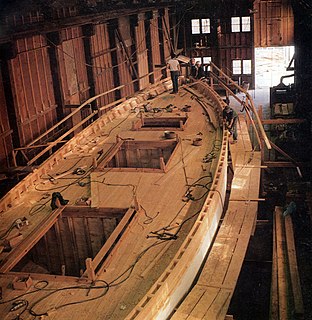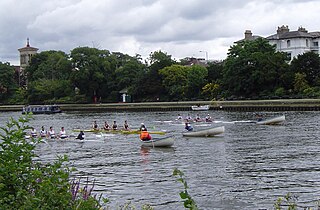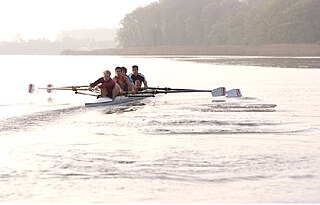
A boat is a watercraft of a large range of types and sizes, but generally smaller than a ship, which is distinguished by its larger size, shape, cargo or passenger capacity, or its ability to carry boats.

A kayak is a small, narrow watercraft which is typically propelled by means of a double-bladed paddle. The word kayak originates from the Greenlandic word qajaq.

Monocoque, also called structural skin, is a structural system in which loads are supported by an object's external skin, in a manner similar to an egg shell. The word monocoque is a French term for "single shell".
Fiberglass, or fibreglass, is a common type of fiber-reinforced plastic using glass fiber. The fibers may be randomly arranged, flattened into a sheet, or woven into glass cloth. The plastic matrix may be a thermoset polymer matrix—most often based on thermosetting polymers such as epoxy, polyester resin, or vinyl ester resin—or a thermoplastic.

Boat building is the design and construction of boats and their systems. This includes at a minimum a hull, with propulsion, mechanical, navigation, safety and other systems as a craft requires.
Strip-built, or "strip-plank epoxy", is a method of boat building. Also known as cold moulding, the strip-built method is commonly used for canoes and kayaks, but also suitable for larger boats. The process involves securing narrow, flexible strips of wood edge-to-edge around temporary formers. The temporary formers are usually created via a process called "lofting" whereby a set of tables is used to generate the shapes of the formers. The strips are glued edge-to-edge with epoxy. It is effectively a modern form of carvel which needs no caulking and which is both stiffer and more watertight. In a small boat, there will be just one layer of strip-planking, but larger vessels may have two or three layers which,, forms a light, strong, and torsionally stiff monococque.

Empacher is a manufacturer of boats. Today, they produce racing shells for the sport of rowing.
In watercraft, a racing shell is an extremely narrow, and often comparatively long, rowing boat specifically designed for racing or exercise. It is outfitted with long oars, outriggers to hold the oarlocks away from the boat, and sliding seats. The boat's long length and semicircular cross-section reduce drag to a minimum. This makes the boat both fast and unstable. It must be balanced by the rowers to avoid tipping. Being able to balance – or "set" – the boat while putting maximum effort into the oars is therefore an essential skill of sport rowing.

Sykes Racing is an Australian manufacturer of rowing shells. The boats are widely popular by Australian rowers from schools through to Olympians.
Pocock Racing Shells is a Seattle, Washington-based racing shells manufacturer, founded in 1911. Pocock Racing Shells is the oldest rowing shell manufacturer in the world.

A sandwich-structured composite is a special class of composite materials that is fabricated by attaching two thin but stiff skins to a lightweight but thick core. The core material is normally low strength material, but its higher thickness provides the sandwich composite with high bending stiffness with overall low density.

An ice hockey stick is a piece of equipment used in ice hockey to shoot, pass, and carry the puck across the ice. Ice hockey sticks are approximately 150–200 cm long, composed of a long, slender shaft with a flat extension at one end called the blade. National Hockey League (NHL) sticks are up to 63 inches long. The blade is the part of the stick used to contact the puck, and is typically 25 to 40 cm long. Stick dimensions can vary widely, as they are usually built to suit a particular player's size and preference. The blade is positioned at roughly a 135° angle from the axis of the shaft, giving the stick a partly 'L-shaped' appearance. The shaft of the stick is fairly rigid, but is slightly elastic to improve shot performance.

A single scull is a rowing boat designed for a single person who propels the boat with two oars, one in each hand.
Michael Louis Vespoli is an American former rower and rowing coach. He is founder and chief executive officer of Vespoli USA, Inc., a boat manufacturer in New Haven, Connecticut, that makes shells for rowing teams and individual rowers. Vespoli was born in New Haven, Connecticut.

A coxed four is a rowing boat used in the sport of competitive rowing. It is designed for four persons who propel the boat with sweep oars and is steered by a coxswain.

A coxless four is a rowing boat used in the sport of competitive rowing. It is designed for four persons who propel the boat with sweep oars, without a coxswain.
Carbon Fiber-reinforced polymers, carbon-fibre-reinforced polymers, or carbon-fiber-reinforced plastics, or carbon-fiber reinforced-thermoplastic, are extremely strong and light fiber-reinforced plastics that contain carbon fibers. CFRPs can be expensive to produce, but are commonly used wherever high strength-to-weight ratio and stiffness (rigidity) are required, such as aerospace, superstructures of ships, automotive, civil engineering, sports equipment, and an increasing number of consumer and technical applications.

The C&C 57 is a Canadian sailboat. The design was built by C&C Yachts in Canada, but it is now out of production.

Alden Rowing manufactures sliding-seat rowing boats. Their original product, the Alden Ocean Shell, was designed in 1970 or 1971. Traditional shell designs use high aspect ratio hulls, with long waterline with minimum beam, that emphasize racing performance at the cost of stability. These types of boats are only usable on flat water. Alden, however, specializes in shorter, beamier, highly stable designs which are suitable for rowing in open water, where swells are commonly encountered. As of 2004, Alden had sold 25,000 shells.
The Evelyn 25 is an American trailerable sailboat that was designed by Bob Evelyn as a racer-cruiser and first built in 1984.












